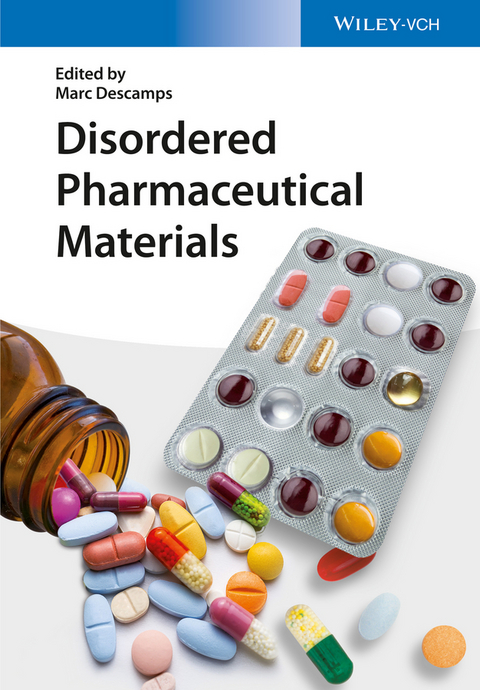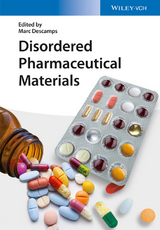Disordered Pharmaceutical Materials
Wiley-VCH (Verlag)
978-3-527-33125-3 (ISBN)
Marc Descamps is Professor for solid state physics at the University of Lille, France, where he initiated the Therapeutic Materials Group. He is the author of more than 180 publications in international journals and he has collaborated with several large pharmaceutical companies. His research interests include: phase transitions in molecular materials, disordered crystals, molecular glasses and studies of the structural and dynamic properties of pharmaceutical solids by a variety of physicochemical techniques. Recently he focused his research on the effects of the mechanical activation of pharmaceuticals.
FUNDAMENTAL ASPECTS OF DISORDER
Disorder and Structure: Existence and Absence of Long Range Order
Disorder and Molecular Mobility
Disorder and Thermodynamics: Entropy and Role of Disorder in the Stability of Physical States
Chemical Disorder
Short Range Organization in Disordered Materials: Static and Dynamic Intermolecular Correlations
RELEVANCE OF DISORDER FOR PHARMACEUTICAL PRODUCTS
Disorder and Solubility
Disorder and Stability (Physical and Chemical)
Disorder and Drug Delivery
Drawback and Opportunities of Disorder
EXPERIMENTAL METHODS FOR THE INVESTIGATION OF DISORDERED MATERIALS
Investigation of Structure: Diffraction Experiments, Spectroscopies
Investigation of Mobility (Relaxations and Vibrations)
Thermodynamic and Calorimetric Investigations
Chemical Aspects
Imaging Methods
HOW DISORDERED CAN PERFECT MOLECULAR CRYSTALS BE?
Condition for the Existence of a Crystalline Order
Disordered Perfect Crystals: Substitutional, Conformational, Rotational Disorder
Crystalline Polymorphism and Disorder
Order-Disorder Phase Transitions in Molecular Crystals
Static and Dynamic Disorder in Crystals: Vibrations, Molecular Rotations, Solid Solutions
Defective Crystals
Dislocation Disorder
Microcrystalline Order
Experimental Consequences
AMORPHOUS AND GLASSY STATE
Molecular Organization in Amorphous Molecular Solids
Intermediate Range Order
Metastability and Instability of Amorphous Materials
Crystallization out of the Amorphous State; Vitrification Condition; Glass Transition at Tg
Molecular Mobility in the Amorphous Materials Above and Below Tg
Aging of Glasses
Glass Transition of Solutions
AMORPHOUS PHARMACEUTICALS
Preparation Techniques: Spray Drying, Freeze Drying, Extrusion, Milling
Impacts of Glass Properties on Mechanical and Surface Properties: Agglomeration, Flowability, Caking, Dissolution
Stability Issues and Possible Stability Manipulations
Amorphous Intermediates in Cocrystal Formation
MESOMORPHIC MATERIALS FOR DRUG DELIVERY
Liquid Crystals
Plastic Crystals
Macromolecular Disorder
Solubilities of Drug in Polymer
Release of a Drug from Dissolving Polymer
Gel Formation, Hydrogels
NUMERICAL MODELING OF DISORDERED PHARMACEUTICAL MATERIALS
Validity of Force Fields Used in Drug Molecular Modeling
Property-dependent Choice of Simulation Models
Modeling and Prediction of Properties
Modeling as an Help to Interpret Data
PROCESS AND DISORDER
Disorder Accidentally or Unavoidably Produced in the Course of Processing Ordered Materials
Processing of Disordered Materials
PATENTING OF DISORDERED PHARMACEUTICAL PRODUCTS
| Erscheint lt. Verlag | 18.5.2016 |
|---|---|
| Verlagsort | Weinheim |
| Sprache | englisch |
| Maße | 170 x 244 mm |
| Gewicht | 1300 g |
| Themenwelt | Medizin / Pharmazie ► Pharmazie |
| Naturwissenschaften ► Chemie | |
| Naturwissenschaften ► Physik / Astronomie | |
| Technik ► Umwelttechnik / Biotechnologie | |
| Schlagworte | Biomaterial • Biomaterialien • biomaterials • biomedical engineering • Biomedizintechnik • Chemie • Chemistry • Clinical & Experimental Medical Research • Klinische u. experimentelle medizinische Forschung • Materialwissenschaften • Medical & Health Physics • Medical Science • Medizin • Pharmaceutical & Medicinal Chemistry • Pharmazeutische Chemie • Pharmazeutische u. Medizinische Chemie • Physics • Physik • Physik in Medizin u. Gesundheitswesen |
| ISBN-10 | 3-527-33125-5 / 3527331255 |
| ISBN-13 | 978-3-527-33125-3 / 9783527331253 |
| Zustand | Neuware |
| Informationen gemäß Produktsicherheitsverordnung (GPSR) | |
| Haben Sie eine Frage zum Produkt? |
aus dem Bereich




